A look at Japan’s demographic collapse, through the eyes of its youth
According to Prime Minister Fumio Kishida, the world’s third-largest economy is on the brink of social dysfunction, which has been brought about by a rapidly-aging population. The stories and opinions of members of the younger generations reveal the challenges that lay ahead for a very conservative society
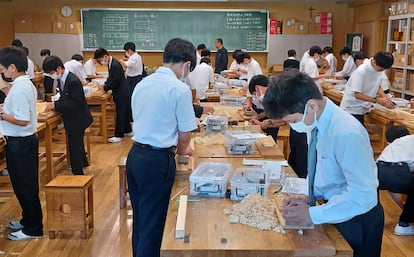

It’s that time of the afternoon when there should be a great bustle at the school gates, with children leaving and parents or grandparents picking them up. But at the entrance of the Imakumano School in Kyoto, Japan, there is silence. Only Hikari Yurugi, 27, stands outside. She studied at the school, just like her father before her. But the baby she is carrying will not. Imakumano closed almost a decade ago, because in Japan, there are fewer and fewer children. The country is experiencing a demographic collapse of serious dimensions. So much so that, in January, Prime Minister Fumio Kishida said that Japan is “on the verge of being unable to maintain its social functions.”
“It is now or never,” he declared, assuring the public that reversing this trend will be his most important policy objective.
About 1.2 million people were born each year in Japan in the mid-1990s, when the country was entering a long phase of economic stagnation after decades of extraordinary growth. In 2022, fewer than 800,000 babies were delivered, with a much faster declining curve than expected. This has triggered a lot of anxiety.
The Japanese government projects that, if this trend is not reversed, the country’s current 125 million inhabitants will drop to 100 million around 2050. The population is expected to fall even lower — to 60 million — by the end of the century. The demographic curve is so steep that it puts the country’s future in doubt. There are questions about Japan’s ability to sustain the burden of pensions and care for the elderly, or to have a healthy workforce made up of young people with sufficient innovative capacity to boost the economy.
The Imakumano School is a symbol of a national pattern: some 500 schools close in the country every year. Nomura Holdings — Japan’s largest investment bank — estimates that there are more than 10 million empty properties. Large chunks of Japan are falling into disrepair.
Birth and aging issues are widespread phenomena in the developed world. Countries such as Spain or Italy also face similar challenges. But in Japan, they are especially acute, because they arise in a society with a very strong attachment to traditional values that, among other things, hinders the path towards gender equality or openness to foreigners… important keys to overcoming the crisis. Thus, together with South Korea, Japan stands out among the countries that are in the greatest demographic trouble. The country’s conservatism is reflected in the political sphere, as the right-wing Liberal Democratic Party has ruled Japan almost uninterruptedly since 1955.
Along with the demographic crunch, the contemporary geopolitical reality is also challenging post-war Japan’s identity in another sense, causing society to question its policy of pacifism. The disturbing rise of China, Beijing’s friction with Washington and North Korea’s rockets are all pushing Japan to alter its traditional hyper-contained post-World War II defense policy.
If adapting to modern times — be it because of climate change or major technological shifts — is difficult for everyone, for Japan it represents a profound interrogation of identity. Japan remains the third-largest economic power in the world. It is also on its way to becoming a country with significant modern military capacity, in view of the large increase in budgeted defense spending. It’s a country endowed with multinational companies and high technological potential, in addition to having a safe, orderly and refined society, with an admirable quality of life. All of this, however, is threatened — as its prime minister points out — by challenges of an existential nature.
What follows is a look at these challenges, the present and the future of the country, through the personal stories and points of view of a handful of young people. This small portrait of Japan is made up of a selection of youthful voices that were recorded in mid-May of this year, in the cities of Tokyo, Yokohama and Kyoto. Some are students, others are workers, some have partners, some are expecting children. Hikari Yurugi, while pregnant and standing outside her former school, starts off this mosaic. Like many others of her generation, she is skeptical about the possibility of a profound change in her country.
HIKARI YURUGI
The economic challenge
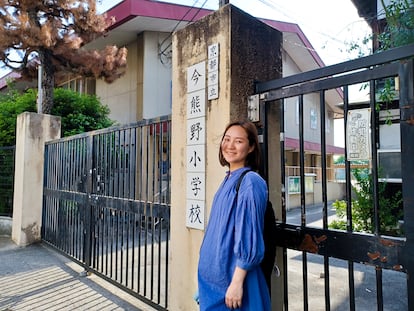
Hikari Yurugi walks agilely through the streets of her neighborhood, despite her six-month pregnancy and the unusually hot May afternoon. In one of the alleys, two elementary school students can be seen walking home from a school that is further away, with their identically shaped backpacks – a small symbol among many in a society governed by a multitude of canons, structures, norms, hierarchies and very strong traditions.
Yurugi wanted to get away from these restrictions. After finishing her degree, she started working at a local company, Nissha, which specializes in the production of industrial and medical materials. As the unofficial canon in Japan dictates: find a job after finishing your studies and, from there, work long hours with few vacations. But she strayed from this path.
“I was so young, it seemed wasteful to spend so many hours in front of a computer. I wanted to use my body,” she explains. So, she went to live in the small Amami archipelago, north of Okinawa.
She lived there for a while, breaking away from the traditional framework. She took on various jobs, until her mother’s cancer forced her to return to Kyoto. While Yurugi’s mother was able to attend her daughter’s wedding last year, she will not be able to meet her granddaughter. “She told me, ‘do what you like,’” Yurugi recalls.
She tried… but her experience is reminiscent of the lingering influence of traditions and the consequences of straying from them. Now, she works (part-time) in a company. “When you leave a full-time position, it’s hard to get another. Maybe I could have done it little by little, but now, motherhood is another obstacle,” she notes.
Japanese society hopes that the established path will be followed. Those who instead choose to follow their instincts are vulnerable to many difficulties in such a rigid country. However, even following the orthodox path is not very conducive to parenthood: Japan has long work hours, few vacations, traditionally high housing costs for small spaces, as well as a system that offers inadequate public services.
“I think that the low birth rate is, above all, an economic problem. It’s necessary to [make] important investments in education and health,” says Yurugi. In 2021, the National Institute for Population and Social Security Research published a survey, which found that 53% of respondents expressed that the high cost of raising children — including paying for their education — was a major reason for having fewer children, or no children at all.
It may come as a surprise that, in a prosperous society like Japan’s, the economic component is an important brake on child-rearing. Public education is free only until children reach the age of 15 but in any case, families want private education for their children across the board, because it’s considered better. Care in nurseries or the health system is not universally covered. Prime Minister Kishida has recognized that action must be taken to change this situation. On Thursday, June 1, he announced his intention to redouble public spending on childcare, to bring it up to the level of Sweden.
Yurugi deviated from the standard path, but she doesn’t reject the traditions of her country. However, she has no doubt that Japan needs a change of direction. When asked if there is a need for a change, she replies emphatically: “Of course! But I’m not confident that it will happen. The leaders are older… I don’t think they have any interest in a big change. The press isn’t very brave. And the young people seem, to me, to be exhausted. I vote, but most [people of my generation] don’t even do that.”
HIBIKI SUGII
The growing desire to emigrate
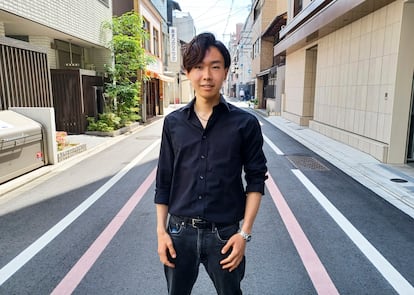
Sugii, 20, was born in Fujieda, a small town between Tokyo and Kyoto. He moved to Kyoto to attend university — a big leap for the smiling young man. But the next leap he has in mind is even bigger: moving abroad.
This longing — common in other nations, even prosperous ones — has been much less prevalent in Japan, which, traditionally, has been a very closed society. Just over 500,000 Japanese live permanently abroad: 0.4% of the resident population. Another 700,000 went abroad in 2022, for long-term stays of more than three months. By comparison, Spain, for example, has some 2.8 million residents abroad, equivalent to 6% of its population. But the number of Japanese leaving is growing. And, above all, it is the younger people who depart. This is another potential complication that could exacerbate the demographic challenge.
“Young people in Japan aren’t very happy,” says Sugii, with a frankness that’s uncommon. “Here, you don’t feel very free to find your own path. We’re a bit of a herd. We go with the flow… we act while thinking about what others will think. I don’t feel very comfortable with this way of thinking. The weight of tradition is a bit stressful. I’m quite motivated to go live abroad.”
Jung-Eun Lee, a senior immigration researcher and part-time professor at Ritsumeikan University, says she has observed a shift in recent years, with young people demonstrating increased interest in learning English and going abroad. She also believes that there’s a change in values in the new generation. “Some things are changing, but not the structure. It’s a society with strong roots in history. They change little things, but they don’t dig, they don’t touch the foundations.”
Sugii — who has a passion for making lo-fi hip hop music — expresses ideas that reveal a clear generational gap. He believes that society should be much more feminist and he’s completely comfortable with the idea of increasing the Japanese arsenal. “I agree with increasing military spending and having more weapons. Nuclear, no, but the normal ones, yes. I don’t want them to be used but I think it makes sense, to prevent others from having bad ideas and to not be so dependent on the U.S.”
AKIHO KOBOKAYAMA
The motherhood-career dilemma

“When I think about my future, I think I’m at a crossroads. I haven’t decided anything yet, but I feel as if I’m facing the dilemma of my life. The ideal would be to be able to have a career and a family,” says Akiho Kobokayama, 32. She was born in Hiroshima Prefecture and moved to Tokyo 10 years ago to study. Now, she works in the capital, at the Shinto Tsushin advertising agency.
The participation rate of women in the labor market has increased in Japan, from 60% at the beginning of the 2000s to 74% today. This growing figure is of enormous importance in a country with a shortage of workers.
However, the practical conditions of this positive integration are shaky, with persistent inequality in wages and positions of power. On top of that, motherhood still hinders professional prospects. While these problems are common across several advanced democracies, a broad consensus of experts states that they are more accentuated in Japan.
Kobokayama’s dilemma is undoubtedly one of the elements that influences the demographic decline of Japan. “I think that, in Japan, compared to before, it’s easier for women to work. The difference occurs when the time comes to get married [and] give birth. At this stage, men have more advantages,” she says at her company’s headquarters in Tokyo’s Ginza neighborhood.
She says that many of her friends from Hiroshima are married. Some already have children. On the other hand, none of her friends from the University of Tokyo are married. “I contemplate the option of being happy without marriage and children,” she says, indicating a clear cultural shift away from the common views of past generations.
Kobokayama’s place of origin — Hiroshima Prefecture, a global symbol of nuclear horror — influences her vision of the geopolitical change facing the country. “In Hiroshima, we have a relatively strong awareness of the value of peace and of nuclear risks. Young people in Tokyo don’t have much interest in these issues or in the prospect of a possible change to the constitution. I think it’s necessary to educate ourselves more about this.
“I understand the defense requirements,” she continues. “I understand that the demographic decline, among other things, represents a problem if, in the future, it’s necessary to recruit forces to defend ourselves. At the same time, I believe that there cannot only be a focus on defense: young people must learn more about the meaning of peace and war.”
When asked if she’s happy, she replies: “I would like to know what happiness is. But I can say that I feel satisfied. I don’t have big worries.”
LAURA PANO
The obstacles to immigration
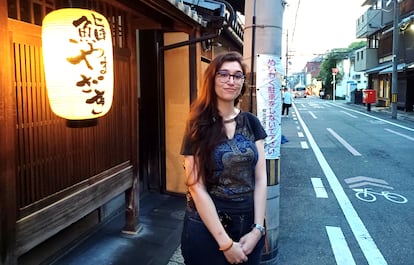
“As a foreigner, you never feel perfectly integrated,” says Laura Pano. A 30-year-old Italian, she lives in Kyoto, where she works for a company in the video game industry. She began to embrace Japanese language and culture during her university years in Italy. She decided to move to the East Asian country before the pandemic, drawn to the many attractive features of Japanese society.
Pano is one of the 2.7 million foreign people residing in Japan. They represent just over 2% of the total population — a small number when compared to the figures of other advanced democracies. The data is a reflection of a society that has traditionally been reluctant to accept immigration, something that could be a palliative for the demographic decline.
The Japanese government has tried to make regulations more flexible in recent years to attract labor, but little progress has been made. In fact, during the years of the pandemic, the number of foreigners dropped. Japan’s language and strong cultural roots — along with rigid legislation and other factors — inhibit the attraction and full integration of foreigners.
“The experience as a student was simple. Difficulties arise when you decide to live here long-term, without being married to a local citizen,” Pano explains. While Japan is a very organized society, at the same time, the rigid rules and customs can be obstacles for foreigners like Pano. Everything from renting a home to fitting into the country’s professional mentality can be a challenge. Pano believes that there are some signs of evolution in Japanese society: she thinks that the position of women in the labor market has improved and that there’s more open discussion about the scourge of sexual harassment. But she feels that the improvement is happening too slowly. “I think that if [Japan] doesn’t make a decisive turn-around very soon, this country will have no future.”
SEIKO GAKUIN INSTITUTE
The struggle for educational equality
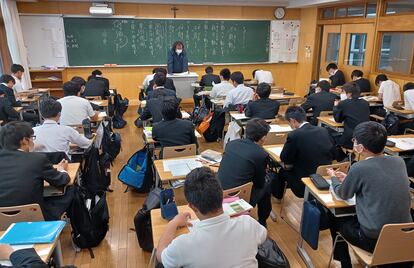
In a quiet area of Yokohama, with narrow streets that give off a village feel, is the Seiko Gakuin Institute. Unlike the Imakumano School, this center is still active and filled with students, even decades after its foundation. It’s a private, Catholic, all-boys high school. Many of the students who graduate from Seiko Gakuin continue their educational journey at the top universities in Japan.
Professor Seiichi Kudo, 68, has been director of the institute for two decades. When he began teaching more than 40 years ago, twice as many children were born in Japan than today and the economy was growing strongly. Before his eyes, he’s seen generations with very different perspectives grow up. The professor points out that, for approximately two decades, a subject that aims to underline the importance of gender equality — of sharing tasks between men and women — has been taking hold in Japanese educational systems.
Kudo emphasizes that the Seiko Gakuin Institute pays special attention to this issue. “We think this is important for a school that prides itself on excellence and whose students are going to be part of the future ruling class. Leaders must be aware of the socio-economic situation and learn about gender equality, [as well as the] distribution of domestic tasks.”
Kudo’s school is a symbol of the growing awareness that some courses need to be adjusted. And, among those interviewed, there’s a similar consensus that things are changing… albeit too slowly.
ANNA KUROKAWA
The elusiveness of paternity leave
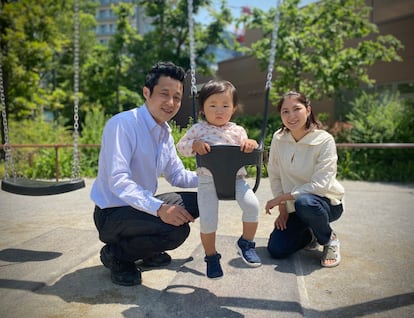
Anna Kurokawa is 35 years old. She’s a journalist at the private channel TBS and the mother of Ari, who is 14 months old. Kurokawa is currently on maternity leave. Her husband — a producer at the same media group — didn’t take a single day of paternity leave when their daughter was born. He says that he couldn’t: with the workload he had, it was impossible.
Kurokawa’s story shows how change in Japan requires very thorough legislative actions, because, in the shadows, old traditions and work cultures prevail.
Kurokawa and her husband hold modern, rather liberal views. They point to what they consider to be an excessively competitive culture within which many parents raise their children — one that results in overspending on a child’s education. However, when asked about Japanese values that should be preserved, the answer they give is “the culture of the good craftsman” — a very traditional reference in Japan, about always determinedly seeking perfection with iron-clad discipline.
RIKUTO FUKUDA and YOKO WATANABE
The persistent military taboo
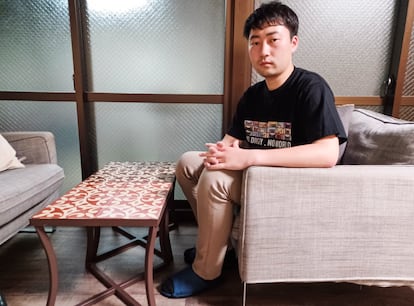
There’s a potluck in the common kitchen of the Oak House residence in Kyoto, where the majority of the renters are young people. As they eat, they talk about Japan, the country’s identity, as well as the challenges that lie ahead.
32-year-old Yoko Watanabe is a chef. She declares herself strongly against the rearmament of her country. She explains that her grandfather was a soldier in World War II and never fully mentally recovered from that experience. Rikuto Fukuda, 25, a municipal architect, notes that these issues are not spoken about much in society. Other dinner attendees agree. It was taboo for a long time and, according to Fukuda, it’s still not dealt with naturally, despite the fact that it’s a hugely important matter.
Fukuda says that he would like to have children. Watanabe — who has five brothers and sisters — would like to have three. Neither of them have any offspring yet.
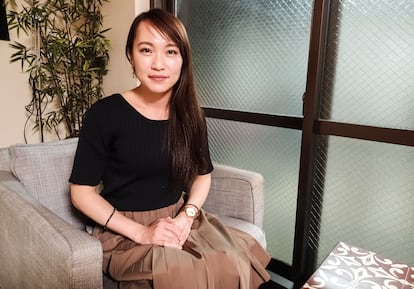
Prime Minister Kishida has stated that Japan’s mission is to create a “children first” economy. He claims that the administration is studying multiple measures to accomplish this. Japan must hurry up. Birth rates have dropped so sharply that it threatens the very stability of the system. At the moment, many more shuttered schools are on the horizon, such as the Imakumano School in Kyoto, where Hikari Yurugi says goodbye. She’s skeptical about the idea that her country will achieve a profound change. But she does want to have another child. Japan needs more young people with that spirit.
Sign up for our weekly newsletter to get more English-language news coverage from EL PAÍS USA Edition
Tu suscripción se está usando en otro dispositivo
¿Quieres añadir otro usuario a tu suscripción?
Si continúas leyendo en este dispositivo, no se podrá leer en el otro.
FlechaTu suscripción se está usando en otro dispositivo y solo puedes acceder a EL PAÍS desde un dispositivo a la vez.
Si quieres compartir tu cuenta, cambia tu suscripción a la modalidad Premium, así podrás añadir otro usuario. Cada uno accederá con su propia cuenta de email, lo que os permitirá personalizar vuestra experiencia en EL PAÍS.
¿Tienes una suscripción de empresa? Accede aquí para contratar más cuentas.
En el caso de no saber quién está usando tu cuenta, te recomendamos cambiar tu contraseña aquí.
Si decides continuar compartiendo tu cuenta, este mensaje se mostrará en tu dispositivo y en el de la otra persona que está usando tu cuenta de forma indefinida, afectando a tu experiencia de lectura. Puedes consultar aquí los términos y condiciones de la suscripción digital.
More information
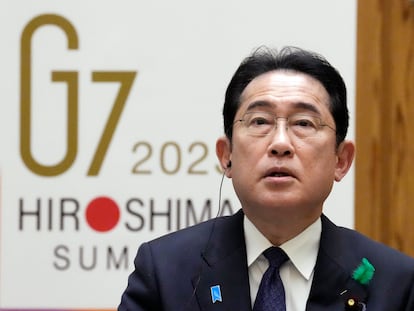
Fumio Kishida: The prudent politician who wants to change Japan
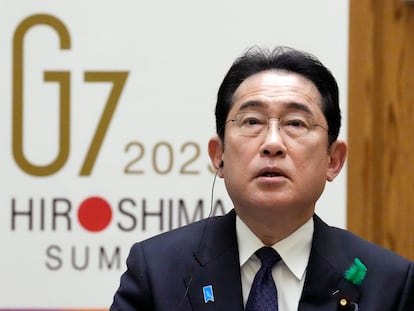
Japan seeks a new identity in a world roiled by change
Archived In
Últimas noticias
Welcome to the post-religion era: The idea of Christianity as the absolute truth has become obsolete
‘I thought you would like it’: The risky sexual practice popularized by TV shows and TikTok
The digitalization of tourism: ‘They promise experiences and gave us the worst possible one’
Mexican peso defies uncertainty with forecasts of a new period of stability in 2026
Most viewed
- Sinaloa Cartel war is taking its toll on Los Chapitos
- Reinhard Genzel, Nobel laureate in physics: ‘One-minute videos will never give you the truth’
- Oona Chaplin: ‘I told James Cameron that I was living in a treehouse and starting a permaculture project with a friend’
- Why the price of coffee has skyrocketed: from Brazilian plantations to specialty coffee houses
- Silver prices are going crazy: This is what’s fueling the rally








































